Listen to the article:
One evening, after dinner, Rori Gossen (they/them) snuggled on the couch as their partner, Millie Turnbull-Innis (she/her), turned on the projector and casted SmallAnt, a Twitch streamer, onto the wall. This was Gossen’s first time watching Twitch — and they sat in curious anticipation. SmallAnt was playing a speed run of their favourite game, The Legend of Zelda: Breath of the Wild.
“I really enjoyed watching him play,” said Gossen.
From then on, Gossen was hooked on video game streams and continued to watch them with their partner and on their own time.
Some people scroll through social media, watch a show, or read a book when they’re bored — others open the Twitch app to watch people broadcast video games and chat with them. In recent years, many people have turned their Twitch hobby into a career.
While there are other broadcasting platforms, Twitch has become one of the most popular over the past decade. According to Mansoor Iqbal’s article on the Business of Apps website, there was an annual average of 0.3 million streamers and 296 million viewers in 2012, and 6.9 million streamers and 18.6 billion viewers in 2020 during the pandemic.

While it may seem like a dream to play video games for a living, there is also a lot that goes on behind the scenes that would-be Twitch professionals need to consider.
What is Twitch?
Twitch is a social platform where users can stream content for a live audience. While it was initially geared towards streaming video gameplay, it has evolved to provide space for graphic designers, artists, and others who use the platform to share their creative content.
Based on Streamers Playbook blog, “Twitch History, From Beginning to Now,” Twitch was founded in 2011 by Justin Kan. Kan started with a channel called Justin.TV where he broadcasted his life and adopted the concept of “lifecasting.”
Justin.TV was sold to Amazon in 2014 and eventually shut down and turned into Twitch.TV.
How does a streamer make money from Twitch?
Madeleine Doe (she/her) is a full-time, Winnipeg-based Twitch streamer who makes a living by focusing on entertaining her viewers through Genshin Impact gameplay (an anime-style Role Playing Game) five hours a day, five days a week.
When viewers join her stream, they’re welcomed with the animation of a sky-high, self-building bridge, extending outwards with the words “starting soon,” and images of female anime characters displayed on either side. After five minutes, Doe, known to her viewers as babiiepeach, pops onto the screen and immediately greets her viewers.
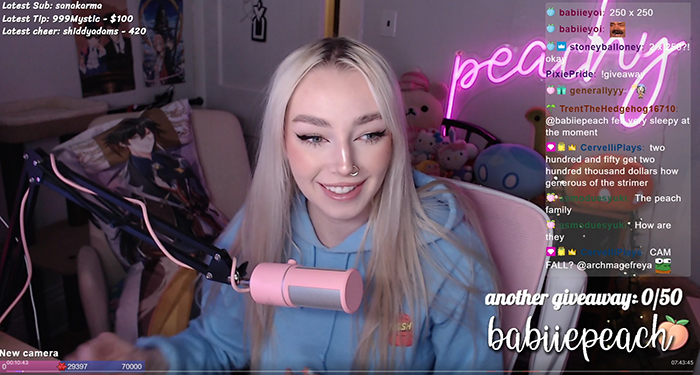
Werner Geyser, founder of Influencer Marketing Hub, says full-time, successful Twitch streamers can expect to bring in between $3,000 to $5,000 every month — this is excluding any ad revenue. But to start earning money on Twitch, streamers need to become an affiliate. The affiliate program allows streamers to earn money from Bits and Subscriptions if they broadcast frequently. Bits are a virtual currency for viewers to use to support streamers, they are used by cheering through pop-up animated emotes and audio cues.
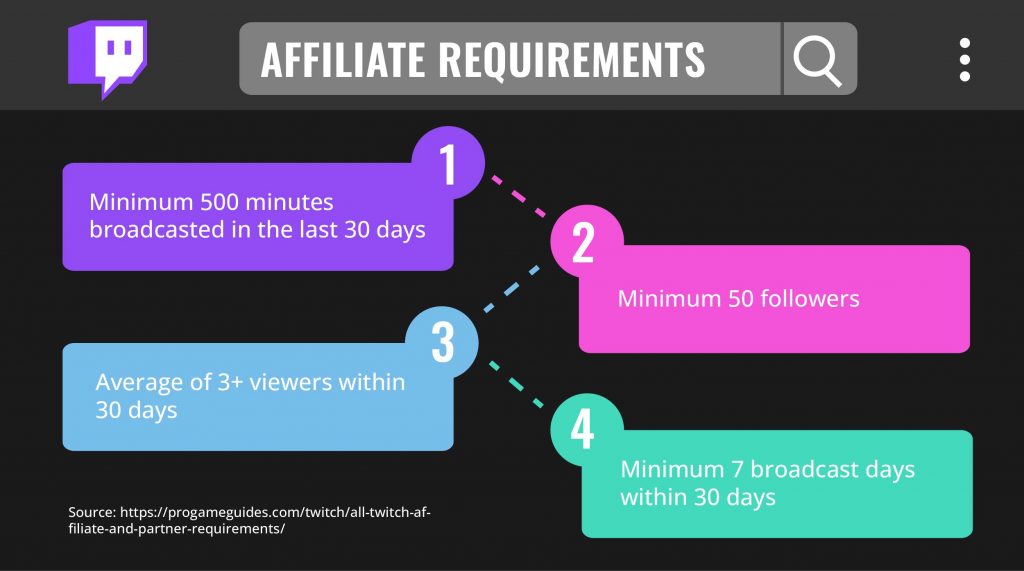
Cam Jr. Sengsuriya (he/him), known as camuriya on social media, started streaming mid-May of 2021. He started out playing video games as a hobby before considering the possibility of making it a career.
When his viewers are notified that he’s gone live, the first thing they see when they join is a drawn-out animated picture of him. The words “starting soon” fade in and out at the top left corner of the screen. As soon as Sengsuriya is ready to jump on stream, his logo appears and he begins welcoming everyone in chat.
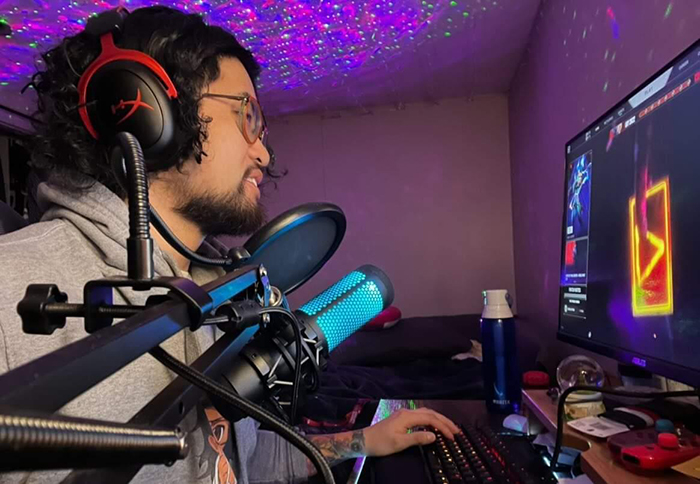
When Sengsuriya started on Twitch, he was affiliated within his first week of streaming. But things slowed down within a month, and he found his weekly follower count dropping from 50 to five.
He remembers thinking to himself, “Well shit, what type of content am I putting out there that I’m only getting five followers?” Going through his VODS (Video on Demand), which are previously recorded streams, made him realize that he was lacking confidence in himself and the content he was creating.
Becoming an affiliate is the first step to becoming a Twitch Partner. Partners are entitled to certain benefits that affiliates are not, like
- Ability to receive more emotes
- 60 days’ worth of streaming storage
- Financial support
- Advertising ability
- Allowing viewers to subscribe to the channel
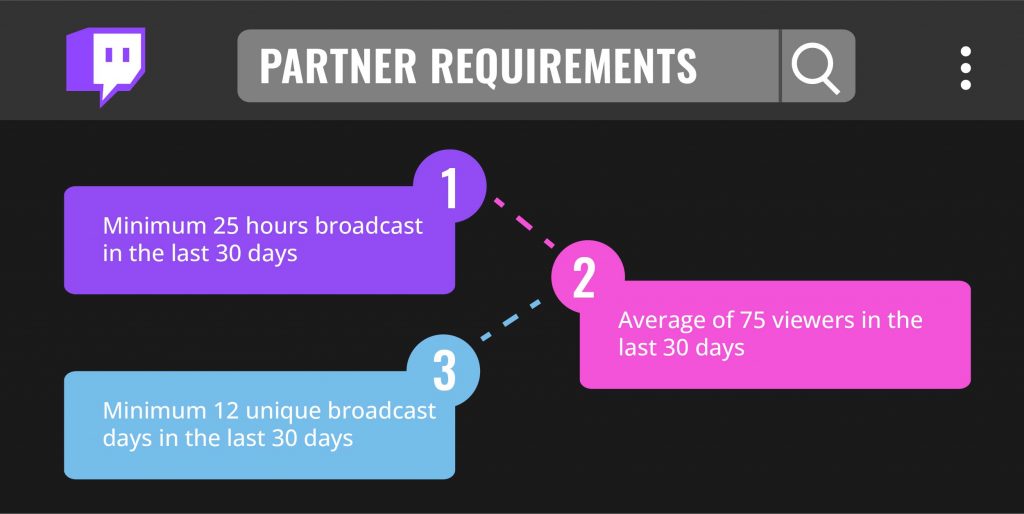
When Doe was applying for her partnership with Twitch, she felt a lot of stress. She realized it wasn’t as easy as she originally thought. Every time she was streaming, she was worrying about her viewer count, which led to her over-analyzing herself. She said she would think to herself, “Oh my gosh, am I not entertaining enough?” At times, her over-analyzing extended past her content to more personal aspects, like her hair and whether her viewers liked the style.
Today, Doe’s biggest stressor is dealing with hate comments. She had to learn to grow thick skin and not worry about the little things people would say to her.
If you’re successful, making money from Twitch can be profitable, but it requires growing a consistent viewership. To set yourself up to succeed, you need to think about your brand and goals.
Creating your personal brand
When streamers broadcast, there are many who put on personas and solely identify themselves based on their gamer tags. Each streamer is unique in their tone, the way they present themselves on stream, their designs, and how they communicate.
Tyler Blevins, also known as Ninja, has successfully thought about his brand. In 2018, Patricia Hernandez wrote about how he became the number one Twitch streamer for The Verge. Most people in the streaming industry know of Blevins. Creating a logo and designing how your stream will look is only part of it, how you present yourself, the way you speak, and look are all factors as well.
Lucia Li (she/her), another Winnipeg Twitch streamer, known as lulu_riri on social media, is a variety streamer, which means she plays multiple games ranging from Japanese Role-Playing Games (JRPG) like Persona 5, to co-operative games like Among Us and Valorant.
Right before Li appears onto her stream, a chibi-style animation of herself pops up with a megaphone and screams out. Li greets all of her viewers with lively energy. Her voice reverberates loudly through the speaker as she talks with her chat — sometimes peaking her audio when she gets really excited.
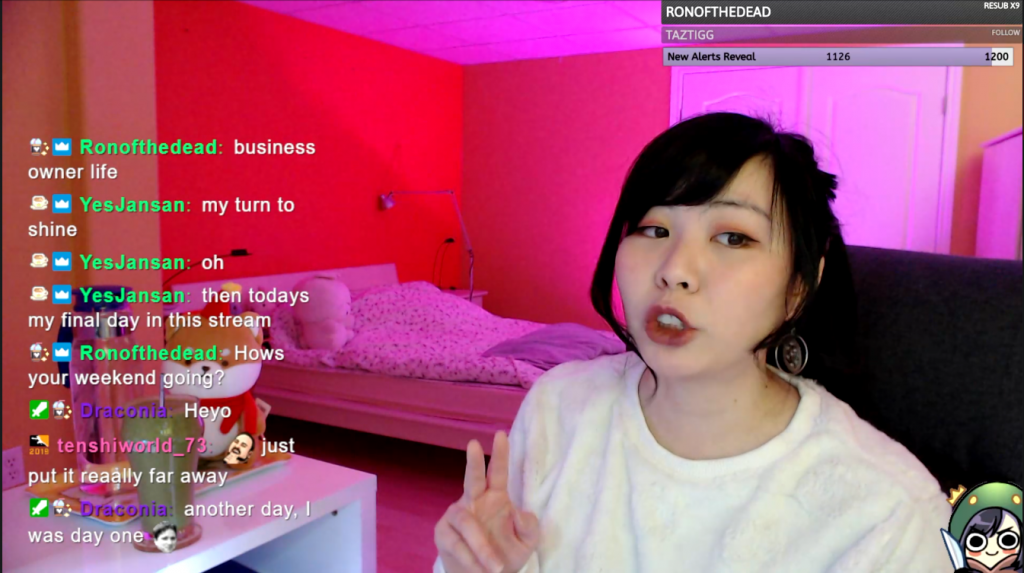
Li says streamers need to think about themselves and the brand they want to show people by designing a banner, creating overlays, opening and transitioning screens.
“You have to think about what suits you,” said Li.
Once you’ve figured out the design aspects, you will need to establish goals for the type of environment you want to create for your community that matches your brand.
Doe has created a safe space for people who want to “hang out and chill” in her streams.
“I want everyone to feel accepted and relaxed in my community,” said Doe.
Sengsuriya hopes that when he streams on Twitch, someone out there might look at his content and think, “oh that’s really great” or “that’s really funny.”
”I want to present that safe space and if I can make people laugh or possibly provide them with a positive experience of some sort, I feel like I kind of conquered what I’ve wanted to do,” said Sengsuriya.
The community Sengsuriya is currently building is for people who want an overall positive gaming experience and to just have fun.
Whether a Twitch streamer decides to broadcast for career purposes or as a hobby, their main goal should be establishing a community. Starting a conversation with viewers seems like a good start to building relationships.
Use social media to build community
Networking can open a lot of doors for streamers. If you can connect with other streamers, find a way to develop and maintain some type of relationship with them, it’s likely that they will be willing to send their followers your way.
Doe believes marketing herself through social media is the best way to increase viewership.
“People want to know streamers’ lives. They want to know what you’re doing on the weekend, what you’re eating,” said Doe. “The more you interact with people, the more invested they’ll be in your community.”
Doe created a Discord server where she keeps in touch with her audience. She recommends using the same social media handle across all social platforms to make it easier for people to find you.
Sengsuriya suggests using public Twitter and Instagram accounts so people can preview your content before committing to following you. He says showing clips from live streams and using hashtags can increase your followers.
“Maybe they’re impressed or intrigued, so they click on it and find my channel,” said Sengsuriya. “It becomes this whole cycle of word-of-mouth.”
Another strategy of Sengsuriya’s is reaching out to other communities to hang out and network.
“You want to talk to other people,” said Sengsuriya. “Try to find similarities and differences, things you can work with.”
Li gained viewers by joining a Winnipeg Twitch streamer group, visiting other streamers’ broadcasts, and collaborating with them.
“For small streamers, I don’t care what they’re playing. I’m there to interact with them, and my audience is the same,” said Li. “They’re there to interact with me.”
Similar to Doe and Sengsuriya, Li says if you want to grow, you have to build your following elsewhere, favouring TikTok and Twitter since both are good for discoverability through their algorithms.
“You never know when one of your tweets or TikToks will blow up and attract more viewers to your Twitch,” said Li.
Getting people to join your live stream is one thing, but it’s a different story to have them keep coming back. Anyone can stream a video game, and while building a community is essential, so is having good equipment.
Finding good streaming equipment
To start streaming, you’ll need a PC, or preferred console, and a broadcasting program. But to give yourself a better chance at success, you’ll need to get decent equipment.

Audio is a must
When it comes to any type of video or podcast, creators must ensure that they have clear, quality audio. If they don’t, it’s likely they’ll lose their audience. The same goes for Twitch streamers.
“If the sound is terrible your stream is unwatchable,” said Li.
To overcome this obstacle, streamers should double-check their mic settings and watch their chat bots, looking for other technical issues.
“People don’t want to tune into a stream where it sounds fuzzy, or like there’s a tsunami in your room. You want decent equipment so at least the sounds are good,” said Sengsuriya.
Are webcams essential?
The Twitch platform’s goal is to have broadcasters create their own communities and connect with their viewers. It’s harder for viewers to build that connection with someone they never see.
Most of the big Twitch streamers use a webcam when they broadcast playing video games, but there are many streamers who choose not to. The short answer to the question is people can be successful even without a camera, but there are benefits to using one.
Doe has used a webcam since day one and she thinks other streamers should too because it makes it more personal and helps viewers connect directly with the streamer.
Most of the streamers Gossen watches have webcams, which they appreciated, but they don’t think it’s necessary to have one.
If the streamer’s content is mostly just chatting with their viewers, then Gossen thinks that having a webcam would be a lot more helpful because “then you can connect with the person with more than just their voice.”
Some people aren’t comfortable with showing their faces online, in these cases, there are other options to consider such as 3D avatars. Some streamers use 3D avatars, which can be animated versions of the streamers or customized to whatever they want. The avatars mimic facial expressions and movement.
There are a lot of 3D animator tools to choose from, ranging from free applications to purchasable ones. If you’re a PC streamer, then there’s a free one called Animaze by Facerig on Steam with the option of a subscription if you want more editing choices.
Viewers still can’t directly connect with the person behind the avatar, but Gossen says that “it almost doesn’t matter because you’re able to connect with the character that is the avatar they’re playing as.”
“There’s a level of connection you’re able to attain from that and I think it’s really fun,” said Gossen.
Having good audio and some way to show yourself to viewers is important for them to connect with you, but interacting and talking directly to them will make it much stronger.
Interacting with chat
Anyone who has a Twitch account has the ability to pop into live streams and send messages in the chat to communicate with the streamer and other viewers.
During Doe’s streams, she makes a point to talk directly with her viewers. She wants to form a connection and keep them coming back.
“I will call them by their first name and really try to remember things about them,” said Doe.
It was easier for her when she had a smaller stream, but with a current average of 150 viewers per stream, it’s harder to remember details about each of them. She said she tries to remember birthdays and little things like when they’ve gone on a trip.
“Stuff like that really resonates with people,” said Doe. “They love when you’re that personal with them.”
Though broadcasters will get a lot of people who just want to be a part of their communities, they will also get people who send hate comments and try to ruin their day. In situations like these Doe recommends getting yourself a moderator (mods), also known as a “streamers bodyguard,” to watch over the stream chat. Moderators have the power to ban someone, remove them from the chat, and delete messages. They can be anyone within a streamer’s community or a friend they trust.
Many small Twitch streamers actively interact with their chats during live streams, which can make the viewers feel included and help establish a relationship with them. Even though Gossen doesn’t watch live streams or communicate often within the community, they still enjoy content creators and how they engage with their viewers.
“Twitch streamers tend to interact with their audience as a group of many individuals,” said Gossen. “So even if I rarely say anything in the chat, I still feel like I am a part of that community.”
What really draws Gossen into a stream is if the streamer is good at the game they’re playing, or if they’re engaging with their audience, or simply talking in general about themselves or the content they are creating. They say it keeps it interesting.
Gossen will normally leave a stream if they find the streamer to be annoying, whether it’s their voice that bothers them or how they’re playing a game.
Out of the three times Gossen has tried chatting with the streamer, they were answered twice because they had a small enough following where they had time to read and respond to the message.
“It always felt pretty special to have someone actually read out and respond to my message,” said Gossen.
Bigger streamers who have thousands of viewers tend to not interact with chat as much because the messages come and go too quickly for them to read.
Viewers want to connect with the streamer and watch them for their content, but talking for hours on end can be tiring, so it’s important for streamers to take time for themselves.
Remember self-care
Just like any job, streamers need to be able to take a sick day or take a break. You want to make sure you’re taking care of yourself — especially in the entertainment industry when you’re broadcasting for hours at a time.
Doe suggests that streamers pace themselves and take as many breaks as they need.
It’s common when broadcasting, for Twitch streamers to feel self-doubt and insecure about their content when viewers pop in and out of chat. Li suggests turning off your view count, so you won’t worry about it.
“You should be streaming as if you’re streaming to a million people,” said Li. “The view count dropping up and down will affect you mentally and your performance.”
Having confidence doesn’t come naturally for everyone, but Sengsuriya believes every Twitch streamer should have it.
“It is a bit rocky to start for anyone really. Because you don’t know what to expect, especially when you’re the one who’s now on screen,” said Sengsuriya. “There will be times where you’ll stutter or won’t find the words; something will slip out of your mouth, or you’re overthinking to the point of not functioning on stream, so you become completely quiet.”
He thinks that believing in yourself will help make your content and streaming performance that much better. But if you’re having an off-day, Sengsuriya strongly advises you not to stream to avoid spreading that negative energy with your viewers.
“At the end of the day, they’re on the other side of the screen. They’re watching you for entertainment.”
Have patience
Many people may think streaming is a piece of cake, just like Sengsuriya when he first started. But the truth is that streaming requires patience, proper equipment, putting effort into growing your audience, and most importantly confidence in yourself.
“You have to keep in mind it’s a slow start and there are very few who can immediately start and shoot to the top. You never want to compare yourself to another person,” said Sengsuriya. “Do what you can to the best of your ability and have some fun while you’re doing it, because if you don’t have fun, then what’s the point?”
If you’re a beginner streamer and you want to be successful, consider
- Thinking about your brand and community goals
- Taking advantage of social media to increase your viewership
- Investing in good audio
- Thinking about using a webcam or 3D avatar to show yourself to your audience
- Acknowledging your chat and talking to your viewers
- Getting yourself a moderator you trust
- Remembering to take time for yourself
Whether you’re streaming for fun or to make a profit, in the end, it’s all about entertainment for your viewers and for yourself.
